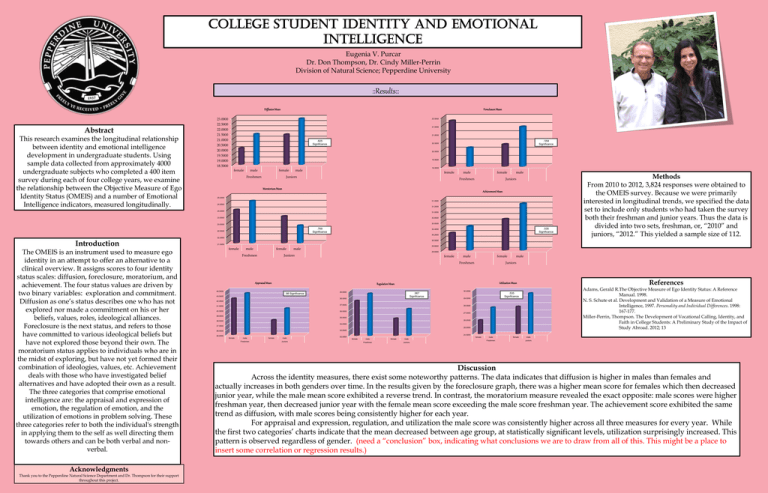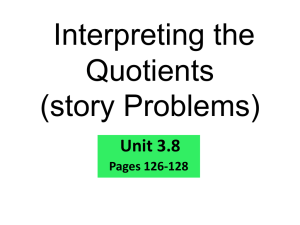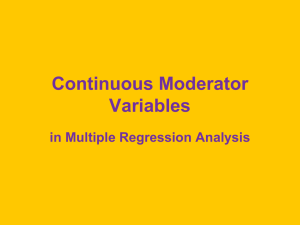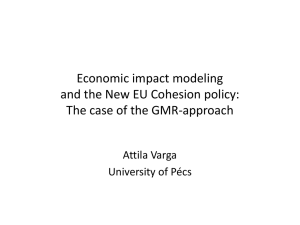College Student Identity and Emotional Intelligence
advertisement

College Student Identity and Emotional Intelligence Eugenia V. Purcar Dr. Don Thompson, Dr. Cindy Miller-Perrin Division of Natural Science; Pepperdine University ::Results:: Diffusion Mean Foreclosure Mean 23.0000 Abstract This research examines the longitudinal relationship between identity and emotional intelligence development in undergraduate students. Using sample data collected from approximately 4000 undergraduate subjects who completed a 400 item survey during each of four college years, we examine the relationship between the Objective Measure of Ego Identity Status (OMEIS) and a number of Emotional Intelligence indicators, measured longitudinally. 22.0000 22.5000 21.5000 22.0000 21.5000 21.0000 21.0000 .825 Significance 20.5000 .’054 Significance 20.5000 20.0000 20.0000 19.5000 19.0000 19.5000 18.5000 female male female Freshmen 19.0000 male female Juniors male female Freshmen male Juniors Moratorium Mean Achievement Mean 25.0000 31.4000 24.5000 31.2000 24.0000 31.0000 23.5000 30.8000 23.0000 30.6000 .769 Significance 22.5000 .535 Significance 30.4000 30.2000 22.0000 Introduction The OMEIS is an instrument used to measure ego identity in an attempt to offer an alternative to a clinical overview. It assigns scores to four identity status scales: diffusion, foreclosure, moratorium, and achievement. The four status values are driven by two binary variables: exploration and commitment. Diffusion as one’s status describes one who has not explored nor made a commitment on his or her beliefs, values, roles, ideological alliances. Foreclosure is the next status, and refers to those have committed to various ideological beliefs but have not explored those beyond their own. The moratorium status applies to individuals who are in the midst of exploring, but have not yet formed their combination of ideologies, values, etc. Achievement deals with those who have investigated belief alternatives and have adopted their own as a result. The three categories that comprise emotional intelligence are: the appraisal and expression of emotion, the regulation of emotion, and the utilization of emotions in problem solving. These three categories refer to both the individual's strength in applying them to the self as well directing them towards others and can be both verbal and nonverbal. Acknowledgments Thank you to the Pepperdine Natural Science Department and Dr. Thompson for their support throughout this project. Methods From 2010 to 2012, 3,824 responses were obtained to the OMEIS survey. Because we were primarily interested in longitudinal trends, we specified the data set to include only students who had taken the survey both their freshman and junior years. Thus the data is divided into two sets, freshman, or, “2010” and juniors, “2012.” This yielded a sample size of 112. 30.0000 21.5000 female male female 29.8000 male 29.6000 Freshmen Juniors female male female Freshmen Appraisal Mean Juniors .98 Significance References Utilization Mean Regulation Mean 44.0000 male Adams, Gerald R.The Objective Measure of Ego Identity Status: A Reference Manual. 1998. N. S. Schute et al. Development and Validation of a Measure of Emotional Intelligence, 1997. Personality and Individual Differences. 1998: 167-177. Miller-Perrin, Thompson. The Development of Vocational Calling, Identity, and Faith in College Students: A Preliminary Study of the Impact of Study Abroad. 2012; 13 30.0000 39.0000 .967 Significance 43.0000 38.0000 .535 Significance 29.0000 42.0000 37.0000 41.0000 40.0000 28.0000 36.0000 39.0000 27.0000 35.0000 26.0000 38.0000 34.0000 37.0000 25.0000 36.0000 33.0000 35.0000 32.0000 24.0000 female male Freshmen Total female male Juniors Total female female male Freshmen Total female male Total male Freshmen Total female male Total Juniors Juniors Discussion Across the identity measures, there exist some noteworthy patterns. The data indicates that diffusion is higher in males than females and actually increases in both genders over time. In the results given by the foreclosure graph, there was a higher mean score for females which then decreased junior year, while the male mean score exhibited a reverse trend. In contrast, the moratorium measure revealed the exact opposite: male scores were higher freshman year, then decreased junior year with the female mean score exceeding the male score freshman year. The achievement score exhibited the same trend as diffusion, with male scores being consistently higher for each year. For appraisal and expression, regulation, and utilization the male score was consistently higher across all three measures for every year. While the first two categories’ charts indicate that the mean decreased between age group, at statistically significant levels, utilization surprisingly increased. This pattern is observed regardless of gender. (need a “conclusion” box, indicating what conclusions we are to draw from all of this. This might be a place to insert some correlation or regression results.)











